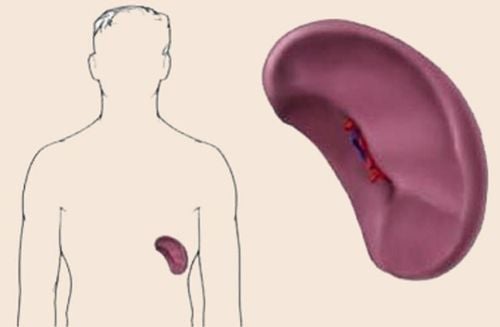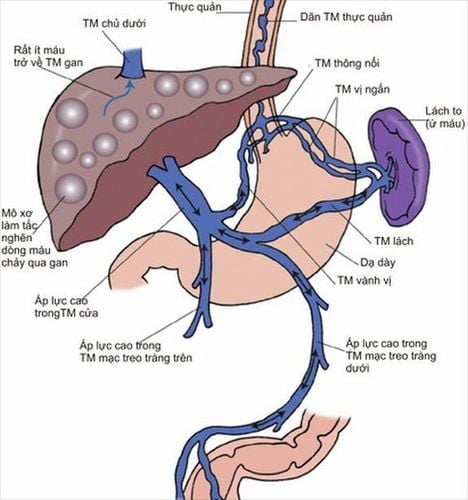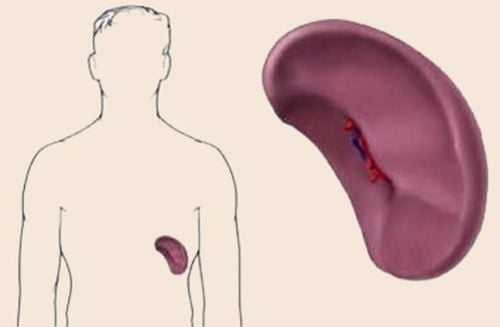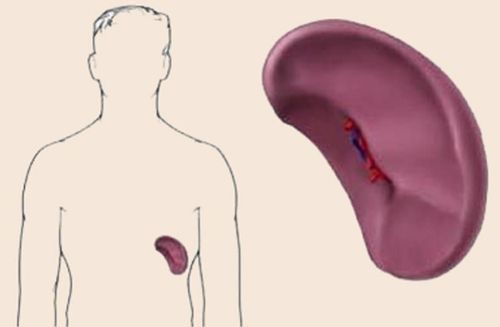This is an automatically translated article.
Spleen enlargement is a common symptom in many diseases such as liver diseases, blood diseases, portal vein diseases, etc. Because it is a valuable diagnostic sign in the diseases mentioned above. Therefore, during clinical examination, special attention should be paid to diagnosis and grading of splenomegaly.
1. What is an enlarged spleen?
The spleen is a small organ located deep in the abdominal cavity. In the fetal stage, the spleen produces red blood cells, platelets, and granulocytes. In addition, the spleen is also involved in the production of lymphocytes that protect the body.
Before going to the doctor for splenomegaly to classify splenomegaly, each person needs to learn about the causes and symptoms of this condition. Experts assess: Splenomegaly is when the spleen size is from 12-20cm and weighs more than 400g. Common symptoms of splenomegaly are:
Pain or feeling of fullness in the left abdomen, pain may radiate to the left shoulder; Feeling full even without eating or after eating a small amount (due to an enlarged spleen pressing on the stomach); Fatigue, anemia, easy bleeding, frequent infections. Common causes of splenomegaly include:
Infection : Virus mononucleosis, toxoplasmosis or bacterial endocarditis; Cancer: Leukemia, lymphoma, lymphoma; autoimmune inflammatory diseases such as lupus, sarcoidosis, lupus, rheumatoid arthritis; Cancer has spread to the spleen; Injury (possibly from a sports collision); Cyst - 1 sac of fluid that does not contain cancer cells; Large abscess due to infection; Infectious diseases such as Gaucher disease, glycogen storage disease, hyperproteinemia.

Cần hết sức chú ý khi chẩn đoán, phân độ lách to
2. Diagnosis of splenomegaly
During the diagnosis, the doctor can grade splenomegaly. Normally, the spleen is hidden in the thorax and is not palpable (except in young children). Only the opacity of the spleen can be percussed in the posterior axillary line.
Techniques to examine the spleen include:
Visual: When the spleen is enlarged, the doctor can see a raised arch below the patient's left costal margin. However, this case is rarely seen, often cannot be accurately diagnosed; Palpation: To identify the spleen below the costal margin, the patient lies supine or slightly to the right, raising the left arm above the head. The doctor sits on the right side of the patient, uses his right hand to place on the patient's left lower ribs in the middle of the anterior axillary line and the vertical line through the middle of the collarbone. Because the spleen moves according to the breathing rhythm, the patient breathes in deeply, the spleen will touch the fingers; The doctor may also sit on the patient's left side. The patient lies on the right side. The doctor uses the tips of his fingers to gently hook towards the flank of the patient's armpit. When the patient breathes in deeply, the lower pole of the spleen can be palpated; In case the spleen is enlarged to the bottom, the doctor examines it with two hands: one hand is placed above the abdomen, one hand is placed below the back to limit the position of the spleen, clearly seeing the waist into the spleen. With this examination, there will be no renal bobbing sign or lumbar puncture. Percussion: To see the opaque area of the spleen on the inside of the ribcage, the doctor taps strongly from top to bottom along the axillary line; Spleen contraction test: The spleen can change volume due to contraction for many reasons such as suffocation, exertion, touch, bleeding, etc. The doctor can determine the degree of spleen contraction by inject 1mg of adrenaline subcutaneously and then monitor. This test helps to confirm the diagnosis of splenomegaly and shows the fibrosis status of the spleen; Spleen ultrasound: Through the intercostal space, the spleen is enlarged on ultrasound, the owner of the spleen tissue can be seen and the size of the spleen can be measured; Splenectomy: Rarely used because of the risk of bleeding complications. The stroke can be partially limited if the patient is completely immobile in bed after 24 hours. This method is indicated when other techniques cannot find the cause of splenomegaly. Contraindicated to apply splenic puncture if the patient has an infection, is prone to bleeding, is easily touched, or the spleen is enlarged and painful; X-ray: Diagnosis of splenomegaly, differential diagnosis with other tumors in the left lower quadrant.

Lách to trên siêu âm có thể thấy được chủ mô lách và đo được kích thước của lách
3. How to classify splenomegaly?
Splenomegaly is usually in 2 directions: The vertical line goes down to the iliac fossa (vertical spleen) and the horizontal line goes out to the middle of the abdomen (the lying spleen). However, it is possible that the spleen is only enlarged vertically or horizontally, which is not valuable in diagnosing splenomegaly and the cause of the disease.
Splenomegaly can be divided into 4 degrees from small to large:
Grade 1: Lower border of the spleen to nearly 1/4 of the line from the left flank to the navel; Grade 2: Inferior splenic border at 1/4 to 1/2 line from left flank to umbilicus; Grade 3: The inferior border of the spleen lies more than 1/2 way from the left flank to the navel; Grade 4: The lower border of the spleen is transverse or over the navel. Enlarged spleen is easily bruised and broken. Once diagnosed with splenomegaly, the doctor will treat directly at the underlying disease to reduce the size of the spleen to normal. If only splenomegaly is alone, no treatment is needed (except in cases of hypersplenism). Patients with an enlarged or very large spleen should avoid sports activities to reduce the risk of injury causing splenic rupture.
Splenomegaly is a common clinical sign, easy to diagnose. The standard grade of splenomegaly will help the doctor give the most accurate treatment. Patients need to cooperate with doctors in the process of diagnosis and treatment of the disease.
Please dial HOTLINE for more information or register for an appointment HERE. Download MyVinmec app to make appointments faster and to manage your bookings easily.













